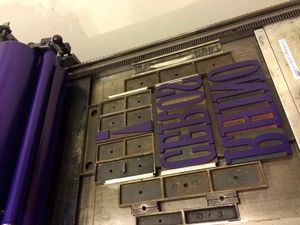Adventures in Letterpress
By Kate Sutherland
Lately, book news has taken an optimistic turn. It’s been reported that millennials prefer paper to electronic books, and that sales at independent bookstores are steadily rising. Hooray on both counts! But a few years back when the market in e-readers was booming and the imminent death of the book was being predicted every other week, I began to consider my own attachment to books as physical objects.
Though I consume plenty of articles and essays on screen, I never took to reading books electronically. I concede the convenience of e-readers when travelling—the idea of being able to carry hundreds of books with me without exceeding luggage weight limits is a very appealing one. I’m also very grateful for online access to rare, ancient tomes that I’d never have had the opportunity to consult had they not been digitized. But given a choice, I always opt for physical books. I like the weight of them in my hands, and being able to see at a glance how far from the end I am. I enjoy good cover art, and may be prompted to buy multiple copies of the same book when I encounter a new edition that I like the look of.
I wanted to go deeper than the cover though. I kept saying that I appreciated books as physical objects, but did I really? What exactly did I know about the construction of a book? I resolved to learn more, and I started with type, the sort that makes a physical impression on the page. I signed up for letterpress classes. I began with an introductory workshop at Open Studio, and after two days of mixing inks, setting wood and metal type, and rolling colourful broadsides off a Vandercook press, I was hooked.
Initially it was about the book, but once I focused on letterpress, I shifted my attention to broadsides. I did a bit of background reading and was intrigued by a law and literature link. Much has been written about broadside ballads, but historically broadsides were as likely to disseminate crime stories, or perhaps both at once, verse accounts of the latest shocking robbery or murder. Invariably the tale would be topped by a woodcut illustration that might not have any connection with the subject matter as such plates were frequently reused. I began to plot a micro-press devoted to publishing broadside poems borrowing this aesthetic.
I signed up for another class, this one stretching over several weeks at Kozo Studio, and promising exposure not just to a Vandercook but also a platen press and a tabletop flatbed press, and access to a fantastic collection of vintage type, cuts, and engravings. And after completing this class and thereby proving a basic level of competence with the equipment, one can rent press time there. I loved every minute of the class (including such lightbulb moments as figuring out what the em in em-dash stands for).
Your CanLit News
Subscribe to Open Book’s newsletter to get local book events, literary content, writing tips, and more in your inbox
But once I progressed to the final project and had my first run at printing a broadside poem, my micro-press plans suddenly seemed much less plausible. It was extremely labour-intensive to lay out all that type by hand, even for a relatively short poem. And in choosing my font, I had to be attentive to whether there was a sufficient supply of each letter within the studio’s collection, lest I run out of, say, the letter e before reaching the end of the poem. I have not yet given up my dream of letterpress broadsides, but unless I restrict myself to publishing very short poems, I’m going to have to investigate the possibilities of polymer plates.
In the meantime, I’ve moved on to another element of book construction, and have signed up for a couple of classes on binding. Still in the small press trenches, I’m now thinking about chapbooks and different styles of pamphlet binding. And regardless of whether I ever bring any publishing plans to fruition, I will consider my forays into letterpress, and now binding (and maybe papermaking after that) time well spent for the enhanced appreciation they have given me of books as physical objects.
The views expressed in the Writer-in-Residence blogs are those held by the authors and do not necessarily reflect the views of Open Book.
Kate Sutherland was born in Scotland, grew up in Saskatchewan, and now lives in Toronto, where she is a professor at Osgoode Hall Law School. She is the author of two collections of short stories: Summer Reading (winner of a Saskatchewan Book Award for Best First Book) and All In Together Girls. How to Draw a Rhinoceros is Sutherland’s first collection of poems.
You can reach Kate throughout the month of October at writer@open-book.ca.




